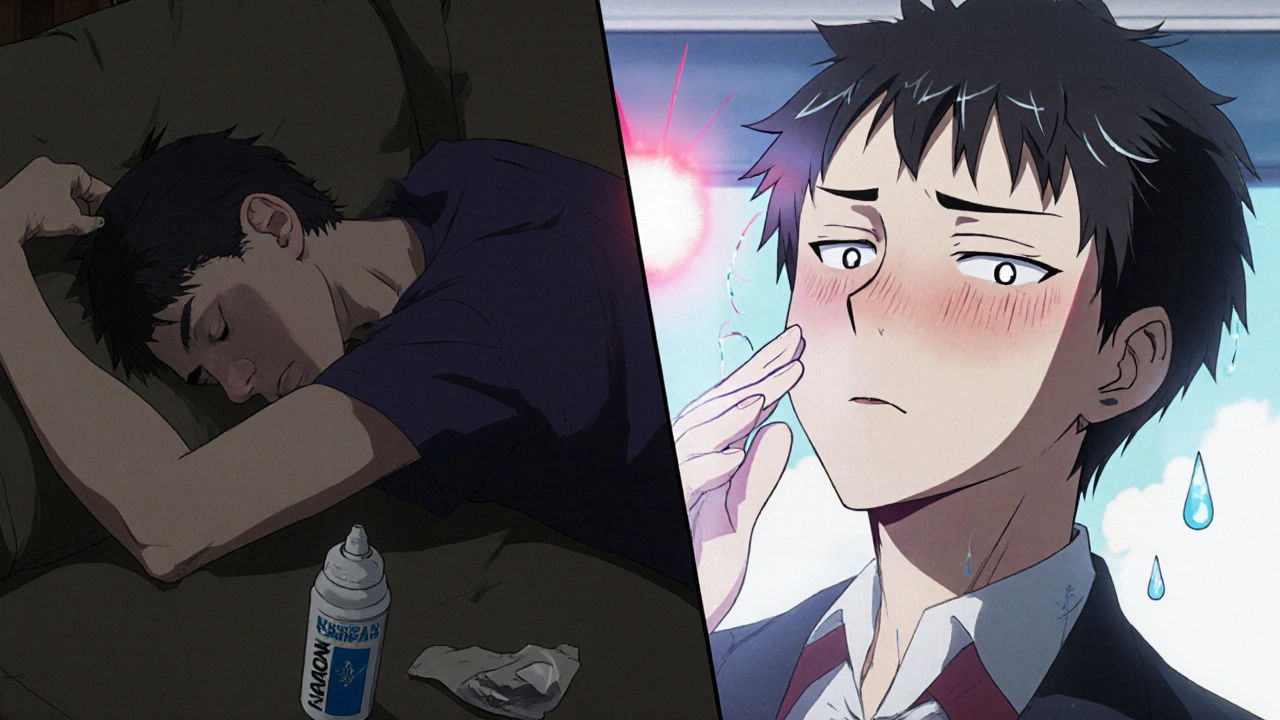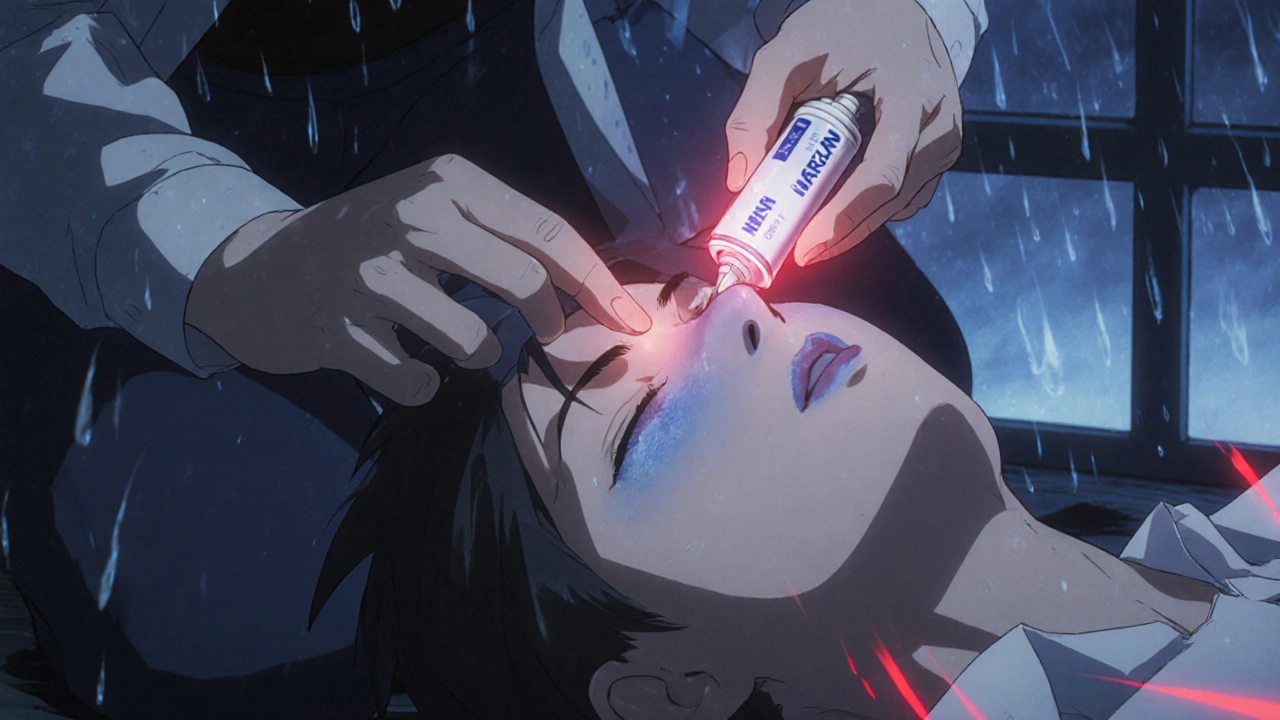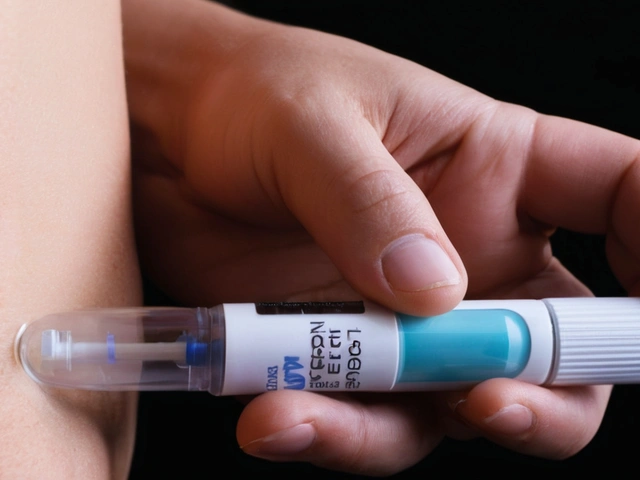When someone overdoses on opioids, every second counts. Their breathing slows, then stops. Their skin turns blue. They don’t wake up-not to shouting, not to shaking, not even to a firm sternum rub. In these moments, naloxone nasal spray isn’t just helpful-it’s the difference between life and death. And you don’t need to be a doctor to use it. In fact, since March 2023, you can buy it over the counter at pharmacies like CVS, Walgreens, and even some convenience stores in the U.S. No prescription. No delay. Just a small, simple device that can bring someone back from the edge.
What Naloxone Nasal Spray Actually Does
Naloxone, sold under the brand name NARCAN Nasal Spray, is a medication that blocks opioids from binding to brain receptors. It doesn’t work on alcohol, benzodiazepines, or stimulants. But if someone has taken heroin, fentanyl, oxycodone, or any other opioid-even if they don’t know what they took-naloxone can reverse the overdose. It doesn’t get them high. It doesn’t hurt them. It just resets their breathing.
The spray delivers 4 mg of naloxone in a single 0.1 mL dose. That’s enough to reverse most overdoses, but not always. Fentanyl and its stronger cousins like carfentanil are so powerful that they can overwhelm a single dose. That’s why you might need to give a second, or even a third, spray.
It works fast. Within 2 to 5 minutes, most people start breathing again. But the effects last only 30 to 90 minutes. Opioids? They can stay in the body for hours. That’s why even if someone wakes up, you still need to stay with them and call 911. They can slip back into overdose once the naloxone wears off.
Recognizing an Opioid Overdose
You don’t need to be sure someone took opioids to act. If they’re unresponsive and breathing abnormally, give naloxone. Here are the clear signs:
- Slow, shallow, or stopped breathing (fewer than 12 breaths per minute, or no chest movement for 15 seconds)
- Pinpoint pupils (tiny dots in the center of the eyes)
- Unresponsive to voice or physical stimulus (try rubbing your knuckles hard on their sternum for 5-10 seconds)
- Blue, purple, or gray lips and fingernails
- Limp body, snoring or gurgling sounds (like they’re drowning in their own saliva)
These signs aren’t subtle. If you’re unsure, err on the side of caution. Naloxone is safe. Giving it to someone who didn’t take opioids won’t hurt them. But waiting to be sure could kill them.
Step-by-Step: How to Use Naloxone Nasal Spray
Here’s exactly what to do-no guesswork, no confusion. Follow these steps in order.
- Call 911 immediately. Don’t wait. Don’t think you can handle it alone. Even if you give naloxone, they still need professional medical care. Say: “Someone is unresponsive and not breathing. I think it’s an opioid overdose. I’ve given naloxone.”
- Position the person on their back. Gently tilt their head back slightly to open the airway. This helps them breathe easier after naloxone kicks in.
- Remove the spray from its package. Don’t press the plunger yet. The device is pre-loaded. You don’t need to assemble anything. Just pull it out.
- Insert the nozzle into one nostril. Gently place the tip as far as your fingers can reach-about half an inch to one inch. Make sure the plunger is facing up. The person’s nose should be between your thumb and index finger.
- Press the plunger firmly until it stops. This delivers the full dose. Don’t tap it. Don’t hold it. Press hard and all the way down. Studies show 18% of first-time users don’t press fully, wasting the dose.
- Remove the spray. Don’t reinsert it. Don’t try to give another dose in the same nostril. You’re done with this device.
- Wait 2-3 minutes. Watch for breathing. Look for chest movement. Listen for normal breaths (12-20 per minute). If they start breathing on their own, that’s good-but don’t assume they’re out of danger.
- If no response, give a second dose. Use a new spray in the other nostril. Don’t wait longer than 3 minutes. Fentanyl overdoses often need two or more doses. In fact, 32% of fentanyl overdoses require more than one spray.
- Put them in the recovery position. If they’re breathing but still unconscious, roll them onto their side. Bend the top knee to stabilize them. Tilt their head back slightly to keep the airway open. This stops them from choking if they vomit.
- Stay with them for at least 4 hours. Even if they wake up, opioids can come back. They need monitoring. Don’t let them walk around. Don’t give them food or water. Just keep them on their side and watch their breathing.

What Happens After Naloxone?
Some people wake up angry, scared, or confused. That’s normal. Naloxone pulls opioids out of their system fast. It can trigger sudden withdrawal-sweating, shaking, nausea, crying. They might yell at you. They might try to run. Don’t take it personally. They’re not mad at you. They’re in pain.
Don’t leave them alone. Stay with them until EMS arrives. Even if they seem fine, they need to be checked in a hospital. Naloxone doesn’t clean their system. It just buys time.
Common Mistakes and How to Avoid Them
People mean well, but under stress, mistakes happen. Here are the most common ones-and how to avoid them.
- Waiting to call 911. Always call first. Naloxone isn’t a cure. It’s a bridge to medical care.
- Not pressing the plunger fully. Practice with a training device. Many pharmacies give them out for free.
- Giving the spray in the wrong nostril. One nostril per spray. Use the other nostril for the second dose.
- Thinking one dose is enough. If they don’t wake up in 3 minutes, give another. Don’t wait.
- Leaving after they wake up. They can overdose again. Stay for at least 4 hours.

Where to Get Naloxone Nasal Spray
You can buy NARCAN Nasal Spray without a prescription at most U.S. pharmacies. It usually comes in a two-pack. One for use, one to keep as backup. Prices vary: around $45-$140 without insurance. Some community health centers and harm reduction programs give it out for free. If you’re in a rural area, check with your local public health department-they often have distribution programs.
Keep one in your car, your bag, your home. Don’t hide it. Put it where you can find it fast-in a coat pocket, a first aid kit, next to your keys. Time matters.
Training and Practice Make a Difference
You don’t need a certification to use naloxone. But practice helps. Watch a 5-minute video on YouTube (search “NARCAN nasal spray demo”). Practice on a training device. Many organizations offer free training: pharmacies, community centers, needle exchanges. In 2022, the CDC found that 92% of people could use naloxone correctly after just 15 minutes of training.
And if you’re worried about legal trouble-don’t be. All 50 states have Good Samaritan laws that protect people who give naloxone in good faith. You won’t get in trouble for trying to save a life.
Why This Matters Right Now
In 2022, over 81,000 people in the U.S. died from opioid overdoses. Most of those deaths involved fentanyl-a synthetic opioid 50 to 100 times stronger than morphine. It’s in fake pills, in powder, sometimes even in small amounts that users don’t know about.
Naloxone nasal spray has already saved an estimated 27,000 lives in the U.S. since 2020. Experts project it could prevent 23,000 to 30,000 more deaths each year if it’s widely available. And it’s not just for drug users. It’s for family members, friends, coworkers, strangers on the street.
If you’ve ever been in a room with someone who uses opioids-even if you don’t know it-you have a chance to save their life. You don’t need to be brave. You just need to be ready.
Can naloxone nasal spray be used on anyone, even if I’m not sure they took opioids?
Yes. Naloxone only works on opioids and is completely safe to give if you’re unsure. If the person didn’t take opioids, it won’t hurt them. If they did, it could save their life. The FDA and CDC both recommend giving naloxone whenever someone shows signs of opioid overdose-even if you don’t know for sure.
How many doses of naloxone might I need to give?
One dose is often enough for heroin or prescription opioids. But for fentanyl or carfentanil, you may need two or three doses. If the person doesn’t respond within 2-3 minutes, give another spray in the other nostril. Some people need up to four doses. Don’t stop until they’re breathing normally or EMS arrives.
Is naloxone nasal spray effective against fentanyl?
Yes, but it’s harder. Fentanyl is much stronger than heroin or oxycodone. It binds more tightly to opioid receptors, so it takes more naloxone to displace it. Studies show that 32% of fentanyl overdoses require two or more doses. Always be prepared to give a second spray if there’s no response.
How long does naloxone last, and why do I need to monitor someone for hours?
Naloxone works for 30 to 90 minutes. But opioids like fentanyl can stay in the body for 4-8 hours or longer. Once naloxone wears off, the opioids can re-bind to receptors and cause another overdose. That’s why you must monitor the person for at least 4 hours-even if they wake up and seem fine.
Can I reuse the same nasal spray device?
No. Each NARCAN Nasal Spray is single-use. Once you press the plunger, the device is empty. Even if you think there’s medicine left, don’t try to reuse it. Always use a new device for a second dose. Keep a two-pack on hand for exactly this reason.
What should I do if I can’t find the naloxone spray in an emergency?
If you don’t have naloxone, start rescue breathing immediately. Tilt the head back, pinch the nose, and give one breath every 5 seconds. This keeps oxygen flowing until EMS arrives. Rescue breathing alone can save lives while you wait for help or a dose of naloxone. Don’t wait for the spray-act now.
Does naloxone work on children or elderly people?
Yes. Naloxone is safe and effective for all ages, including children and older adults. The dose is the same regardless of weight or age. If a child or elderly person shows signs of opioid overdose, give the full 4 mg dose. Delaying because of age or size could be deadly.
Can I give naloxone to someone who is awake and talking?
No. Naloxone is only for people who are unresponsive or having trouble breathing. If someone is awake, talking, and breathing normally, they’re not overdosing. Giving naloxone to them could trigger sudden opioid withdrawal, which is painful and dangerous. Only use it when breathing is severely slowed or stopped.
Is there a risk of overdosing on naloxone itself?
No. Naloxone has no effect on people who haven’t taken opioids. Even if you give multiple doses, it won’t cause overdose or harm. It’s designed to be safe in high amounts. The only risk is triggering withdrawal in someone who is dependent on opioids-but that’s far less dangerous than an overdose.
Where can I get free training or naloxone kits?
Many pharmacies, community health centers, and harm reduction organizations offer free naloxone and training. In the U.S., you can search for local programs through the Harm Reduction Coalition’s directory or call the National Overdose Response Service at 1-800-222-4357. Some cities also distribute kits at libraries, clinics, and public events-no ID or proof needed.







Latrisha M.
November 15, 2025 AT 06:52